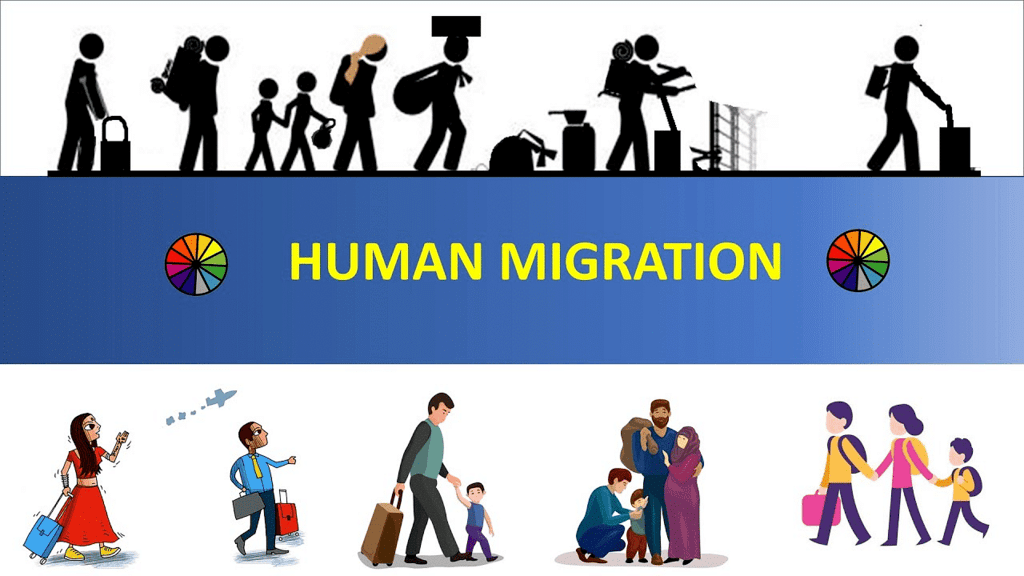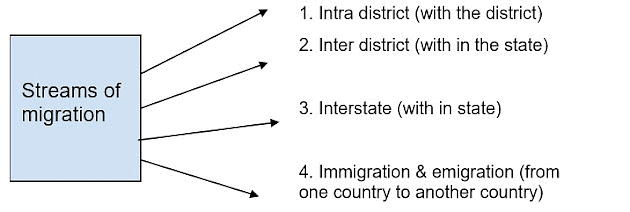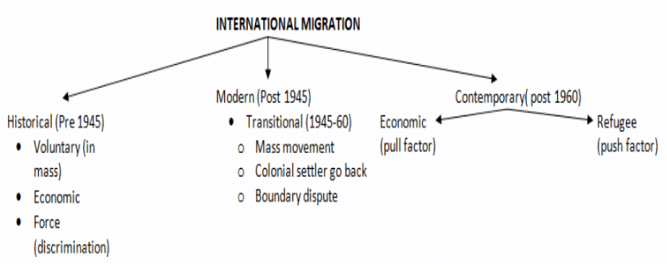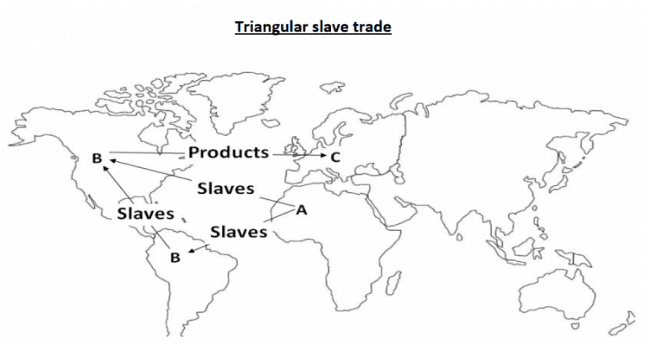Causes & Consequences of Migration | Geography Optional for UPSC PDF Download
| Table of contents |

|
| Migration |

|
| Migration Classification |

|
| Migration and Census of India |

|
| Frequently Asked Questions (FAQs) of Causes & Consequences of Migration |

|
Migration
Migration refers to the movement of people from one location to another, with the intention of settling either temporarily or permanently in a new region. This movement can occur over long distances, such as from one country to another, or within the same country, which is known as internal migration. People may migrate individually, with their families, or in large groups.
- The four primary types of migration are invasion, conquest, colonization, and immigration. When people are forced to leave their homes due to natural disasters or civil disturbances, they may be referred to as displaced persons or, if they remain in their home country, internally displaced persons. If someone seeks refuge in another country for reasons such as political, religious, or other forms of persecution, they can make a formal application for asylum in that country. If the application is successful, their legal status becomes that of a refugee.

- In geography, migration typically involves the movement of humans from one place to another, influenced by the interplay of push and pull factors, as well as the costs associated with moving. Push factors are negative aspects of the origin that encourage people to leave, while pull factors are positive aspects of the destination that attract people to the area. The friction of moving includes the time, financial, and emotional costs involved in relocating from one place to another. The strength of push and/or pull factors must outweigh these costs in order for potential migrants to decide to actually move.
- Perception plays a significant role in migration, as individuals may perceive geographical features differently. For example, a quiet coastal resort may be seen as unappealing by a teenager (a push factor), but attractive to a retired couple (a pull factor). This could result in a net out-migration of young people and a net in-migration of retirees to coastal resorts.
- Net migration refers to the overall change in the number of migrants in an area, taking into account both those coming in (in-migrants) and those leaving (out-migrants). When migration occurs across international borders, an individual is considered an emigrant from the country they leave and an immigrant to the country they enter.
Migration Classification
Migration can be categorized according to various criteria, such as distance, duration, and motive:
1. Classification Based on Distance:
- Intra-building: Movement within a building, such as people moving around an airport terminal or hospital
- Inter-building: Movement between buildings in a complex, like students walking across a university campus
- Local-scale: Relocating to another house within the same town or city
- Regional-scale: Moving from one county or state to another within a country
- International scale: Moving from one country to another, either through emigration or immigration
- Global-scale: Migrating between distant continents
2. Classification Based on Duration:
- Daily: Commuting to and from work each day, resulting in peak traffic hours
- Seasonal: Temporary migration for specific activities, such as winter sports enthusiasts heading to the Alps or summer vacationers traveling to the Mediterranean; nomadic herders moving to fresh grazing lands
- Medium-term temporary: Relocating for a few years to work in an overseas branch of a multinational company, attend university, or earn money in a city to pay off rural debts
- Permanent: Emigrating to another country with no intention of returning
3. Classification Based on Motive:
- Forced (Environmental): Escaping from regions affected by drought, flood, desertification, or volcanic eruptions
- Forced (Political): Fleeing from threats to freedom, safety, and liberty due to religious, ethnic, racial, or political persecution, conflict, or war, resulting in refugees and asylum-seekers
- Collective Behavior: Migrating as part of an identified group to maintain group cohesion, such as traveler communities, nomadic groups, or ethnic groups
- Personal Aspiration: Seeking an improved standard of living for oneself or one's family by pursuing economic and social benefits, like economic migrants
- Personal Well-Being: Moving for health reasons, such as retirees relocating to Florida, or to improve quality of life, like people moving to rural areas for a more relaxed lifestyle
World Migration (International migration)
- Since the beginning of cultural history, it involves well-demarcated temporal category interpreting the practical significance of the Mobility Transition Model.
- Among the definite category of important trends of migration, the historical and modern trends are included –

- The dividing line of the 2nd World War was first drawn by Zimolsak and Stanshield by writing a book named Human Landscape.
Historical Migration
Historical migration, particularly before 1945, involved mass movements of populations across international borders due to various causes, leading to diverse consequences. There are several types of historical migration, including voluntary migration, economic migration, and forced migration. Among these, voluntary migration has had a significant impact on the cultural, demographic, and economic characteristics of different regions.
- Voluntary migration refers to the relocation of European settlers to various parts of the world. The main destinations of these migrants were Anglo-America, South Africa's Cape Province, the eastern highlands of Africa, Australia, and New Zealand. The influence of this migration is evident in the global dominance of the Caucasoid race, Christianity, and the Indo-European linguistic family. Furthermore, this migration contributed to the economic development of Anglo-America and Oceana, as it facilitated the transfer of technology.
- Significant global migration events became more apparent after the 14th and 15th centuries, when Europeans developed sea routes and voyages (e.g., Columbus, Vasco da Gama). European migration to America occurred in two main streams: from Britain to the northeastern United States (now New England) and from Spain and Portugal to South America and the Caribbean. This is why Portuguese is the primary language of Brazil.
- The arrival of Europeans in America had severe consequences for the local indigenous populations, as the invasion led to the near-extinction of the Incas, Mayas (Mexico), and Aztecs (Mexico). Between 1400 AD and 1600 AD, Mexico's native population declined from 12 million to 2 million, and the Native American population dropped from 100 million to 8 million. The Inca population decreased from 13 million in the 14th century to fewer than 500,000 by the 1900s. The European settlers were also responsible for the mixed-race population of South America (Mestizos - a blend of European and native Indian blood). In countries like Argentina and Chile, Mestizos make up nearly 100% of the population.
- Migration after 1800 saw Europeans moving further east, particularly after the opening of the Suez Canal in 1869. They established new colonies in Australia, New Zealand, South Asia, and Southeast Asia. The arrival of Europeans in Australia and New Zealand led to the near-extermination of the native populations (Bindibus of Australia, Maoris of New Zealand).
Economic Migration:
- Economic migration refers to the movement of people, primarily industrial and agricultural laborers, in search of better economic opportunities. This type of migration has led to a diverse cultural and ethnic mix in various regions around the world.
- Industrial labor migration was mainly driven by the pull factor of the Industrial Revolution in Western European countries. This attracted workers from Southern Eastern Europe and Northern Africa, leading to a cosmopolitan cultural identity in Western Europe.
- Agricultural labor migration, on the other hand, was focused on tropical equatorial islands where traditional plantation agriculture was established by colonial settlers. Some of these destinations included Trinidad and Tobago, Cuba for cane plantations, Pemba and Mafia islands, Zanzibar for spice cultivation (mainly cloves), Sri Lanka for tea, Malaysia for rubber, and Fiji and Mauritius. These islands attracted workers from neighboring mainland regions due to a combination of push and pull factors.
- This migration played a significant role in the diffusion of Indian culture to various parts of the world. After the slave trade was banned in the 1800s, a new labor employment system called Indentured Labor began. This system contributed to the migration of Asians, particularly from Kerala, Gujarat, and Maharashtra, to Africa, Southeast Asia, and North America.
- Indian migrants from Gujarat and Kutch settled in Eastern Africa (Uganda, Ethiopia, Tanzania, and South Africa) and the Caribbean Islands. Meanwhile, Chinese migrants moved to Southeast Asia and North America, with Vancouver city having a Chinese population of 20%, making them the largest dominant ethnic minority. In Fiji, Indians make up more than 50% of the population.
- These economic migrations have resulted in the widespread presence of Asian Diasporas across the globe.
Forced migration
- From the 1600s until 1834, when the slave trade was finally abolished, Europeans played a significant role in the forced migration of Africans to South America and the Caribbean. This was done to provide labor for the plantation system under the notorious slave trade. A large number of the African slaves, primarily from Upper Guinea (West Africa), were forcibly relocated to Anglo-America, laying the foundation for the Black population in the United States.
- These enslaved people faced harsh working and living conditions, and their labor was mainly used for clearing forests, leveling land, and establishing the necessary infrastructure for basic development. The forced migration and enslavement of African people led to the intermingling of different populations, resulting in the creation of new mixed races, such as Mulattoes and Zamboes.
- Additionally, this period contributed to the global rise of racial discrimination, particularly in regions with a predominantly Caucasoid population. The forced migration and enslavement of Africans by Europeans during this time had a lasting impact on racial dynamics and the development of new racial identities around the world.

Modern migration
The end of the Second World War marked the beginning of the decline of colonialism and the establishment of a more stable political map of the world, setting the stage for contemporary migratory movements. Unlike historical migrations, these movements involved longer distances and were often more individualistic in nature.
Characteristics of modern migration include:
- Selectivity, as it involved specific groups of people, such as colonial settlers, those affected by partition, and others.
- Temporality, as seen in the settling of Jews in Arab lands.
- Globalization, as colonial settlers from around the world returned to their home countries.
The modern migration period can be divided into two main phases:
- Transitional phase (1945-1960): This phase featured the establishment of a new political map and mass population movements, including:
- The withdrawal of colonial settlers.
- The violent migration during the India-Pakistan partition, in which over 10 million people crossed borders in just a few weeks.
- The movement of Jews from Germany and the US to West Asia following the creation of the state of Israel, displacing local Arabs who now live as political refugees in other Arab countries (especially Jordan).
- Migration within Europe due to the disintegration of the Ottoman Empire, with many North Africans and West Asians (such as Turks) moving to Western Europe.
- Contemporary phase (post-1960): This phase primarily involved economically motivated migration, with the developing world serving as the source area and the developed world as the destination. Notable movements during this period include:
- The construction boom in West Asia during the 1970s, attracting migrant workers who lived temporarily in the region.
- The ongoing migration of professionals from Asia to Europe and new world economies, such as the US, Canada, Australia, and New Zealand.
- Intra-African migration driven by factors such as drought, agricultural failure, and tribal conflicts, leading to the displacement of many Africans.
- Out-migration due to conflicts in Central and West Asia, including the Iraq War, the Afghan War, the disintegration of the USSR, displacement of Kurds, and migration of Hazaras from Afghanistan. These migrants are often classified as refugees or "people of concern" by the Human Development Index report.
In summary, modern migration has been shaped by various factors, including the decline of colonialism, political changes, economic opportunities, and conflicts. It has been characterized by selectivity, temporality, and globalization, with numerous population movements occurring both within and between continents.
Refugee movement
- UN convention on refugees justifies that 9 out of 10 refugee movements across the international borders are from illegal migration which continues to stay in the country, creating challenges on the economic, demographic, and security front.
- Africa
- It is the continent of Africa that such mass movements are most consistent caused due to the reoccurring food scarcity in the Sahel making people migrating to neighboring food-sufficient countries like Nigeria.
- People are also migrating from tribal conflict countries like Uganda, Rwanda, Burundi and going to Kenya, Tanzania, etc.
- Evaluation of the youngest state on the political map of the world, South Sudan has been an additional cause of mass displacement of the population across the international boundary within the continent.

Causes of Migration

- People migrate for many different reasons. These reasons can be classified as economic, social, political, or environmental:
- economic migration – moving to find work or follow a particular career path
- social migration – moving somewhere for a better quality of life or to be closer to family or friends
- political migration – moving to escape political persecution or war
- environmental causes of migration include natural disasters such as flooding
- Some people choose to migrate, eg someone who moves to another country to enhance their career opportunities.
- Some people are forced to migrate, eg someone who moves due to war or famine.
- A refugee is someone who has left their home and does not have a new home to go to. Often refugees do not carry many possessions with them and do not have a clear idea of where they may finally settle.
Push and pull factors
- Push factors are the reasons why people leave an area. They include:
- lack of services
- lack of safety
- high crime
- crop failure
- drought
- flooding
- poverty
- war
- Pull factors are the reasons why people move to a particular area. They include:
- higher employment
- more wealth
- better services
- good climate
- safer, less crime
- political stability
- more fertile land
- lower risk from natural hazards
- Migration usually happens as a result of a combination of these push and pull factors.
Consequences of Migration
Migration occurs as a result of the unequal distribution of opportunities across different locations. People often move from areas with limited opportunities and safety to areas with greater opportunities and safety. The effects of migration can be seen in various aspects, such as economic, social, cultural, political, and demographic.

1. Economic Consequences
Migration can have both positive and negative economic consequences:
- Positive: Remittances sent by migrants to their families contribute to the economy of a country, supporting expenses such as food, loan repayments, medical treatments, education, agricultural inputs, and housing construction. The Green Revolution in rural Punjab, Haryana, and Western Uttar Pradesh was successful due to migrants from rural Eastern Uttar Pradesh, Bihar, Madhya Pradesh, and Odisha.
- Negative: Unregulated migration can lead to overcrowding, resulting in the development of unsanitary slums in industrialized states such as Maharashtra, Gujarat, Karnataka, Tamil Nadu, and Delhi.
2. Demographic Consequences
Demographic consequences can be both positive and negative:
- Positive: Migration helps redistribute the population within a country and contributes to urbanization through rural-urban migration.
- Negative: Selective out-migration based on age and skill can create an imbalance in the demographic structure of rural areas, affecting age and sex composition in both sending and receiving states. This is evident in states such as Uttarakhand, Rajasthan, Madhya Pradesh, and Eastern Maharashtra.
3. Social Consequences
Migration can have both positive and negative social consequences:
- Positive: Migrants can act as agents of social change, spreading new ideas related to science, technology, family planning, and education. They also bring diverse cultures, helping to break down narrow perspectives and broaden the mindset of people.
- Negative: Increased anonymity can lead to a sense of social isolation and rejection, which may result in anti-social behavior such as crime, drug abuse, and theft.
4. Environmental Consequences
- Negative: Large-scale rural-urban migration can cause overcrowding in cities, placing immense pressure on infrastructure. This can result in unplanned and disorganized urban growth, leading to the development of slums and shanty towns. Overcrowding also contributes to the over-exploitation of natural resources, causing issues such as water shortages, air and water pollution, sewage disposal problems, and solid waste management challenges.
Other Consequences
When male migrants leave their wives in rural areas, it can place additional physical and mental stress on women. While migration of women for education and employment can provide them with increased freedom, it may also expose them to greater vulnerability.
Migration and Census of India
Migration data were recorded at the time of the first census in 1881 based on the place of birth. In 1961, modifications were made to include place of birth and duration of residence. In 1971, additional information on the place of last residence and duration of stay at the place of enumeration was incorporated. Information on reasons for migration was incorporated in the 1981 census and modified in consecutive censuses. In the census of India, migration is enumerated on the following two bases: (1)Place of birth: if the place of birth is different from the place of enumeration (known as life- time migrant)(2) Place of residence: if the place of last residence is different from the place of (known as migrant by place of last residence).
Migration in India is primarily of two types
(1) Long-term migration- resulting in the relocation of an individual or household
(2) Short-term migration- involving a back-and-forth movement between a source and destination.
Mostly short-term migration belongs to socially economically deprived groups such as scheduled castes and scheduled tribes having negligible educational attainment, limited assets, and resource deficits. Between2001-11, about 5.65 million people migrated annually. Migration is rising to 4.5 percent per annum in 2001-11 from 2.4 percent in 1991-2001. About 45.31 crore (37%) people in India are migrants and above 80 percent of migrants are males (Srivastava, 2011). The north Indian states of Uttar Pradesh and Bihar have the highest percentage of rural population with 18.6 and 11.1 percent of people living in villages in 2011. These states are the largest migrants sending states. The substantial flow of labour migrants relocates from Uttar Pradesh to Maharashtra, Delhi, West Bengal, Punjab, and Haryana. Other major migrants-sending states are Rajasthan, Madhya Pradesh, Andhra Pradesh, and Jharkhand.9b7 All the major sending states are characterized by low social and economic development. Cities of Mumbai, Delhi, and Calcutta are the largest destinations for internal migration in India. Seasonal migration vary by area and industry. Numbers of people from drought prone areas including Andhra Pradesh, and Karnataka migrate seasonally to work in brick making, construction, tile factory and crop cutting. About 90 percent of labourers in construction industry are internal migrants. Seasonal migration is also attracted by agricultural work such as rice harvest in West Bengal, sugar cane in Gujarat.
Policies for Migration
Due to the increasing trends of shifting people from rural to urban areas, urban areas are suffering from many problems such as slums, high population density, overcrowding, and lack of infrastructural facilities. So, the government has started some rural Development Programmes such as Mahatma Gandhi National Rural Employment Guarantee Act (MGNREGA), Indira Aawas Yojana (IAY), National Social AssistanceProgramme (NSAP), Integrated Watershed Management (IWMP), National Rural Drinking WaterProgramme (NRDWP), Swachha Bharat Mission (SBM) and National Rural Livelihood Mission (NRLM), etc. These programs were also necessary for the development of rural areas of the country but all are not sufficient to stop rural-urban migration. The Provision of Urban Amenities in Rural Areas (PURA) is one of the five major components of former President Dr. A. P. J. Abdual Kalam’s dream, hisvision2020 for a developed India. The PURA defers from the conventional ideas of economic development of rural areas in different ways. It aims at the comprehensive development of rural areas to generate urban-level income and not mere poverty alleviation. It seeks modern industry investment in the migration from rural to urban in intra-state is been increasing slowly with industrialization and modernization in India.Conclusion
In conclusion, migration is a complex process driven by various factors such as economic, social, political, and environmental causes. It can have both positive and negative consequences on the economy, demography, society, and environment of the involved regions. While migration can bring about opportunities, cultural exchange, and social change, it can also lead to overcrowding, resource scarcity, and social challenges. Understanding the factors and consequences of migration is crucial for policymakers and communities to address the challenges and harness the potential benefits of this global phenomenon.Frequently Asked Questions (FAQs) of Causes & Consequences of Migration
What are the main types of migration?
The four primary types of migration are invasion, conquest, colonization, and immigration. Migration can also be classified based on distance, duration, and motive, such as local-scale, international-scale, forced, and economic migration.
What are push and pull factors in migration?
Push factors are negative aspects of the origin that encourage people to leave, while pull factors are positive aspects of the destination that attract people to the area. Examples of push factors include lack of services, high crime, and war, while pull factors include higher employment, better services, and political stability.
What are some consequences of migration?
Migration can have economic, demographic, social, and environmental consequences, both positive and negative. For example, it can contribute to the economy through remittances, redistribute the population, and act as an agent of social change, but it can also lead to overcrowding, demographic imbalances, and environmental degradation.
What is the difference between a migrant and a refugee?
A migrant is someone who moves from one place to another, usually for economic, social, political, or environmental reasons. A refugee, on the other hand, is someone who has been forced to flee their home country due to persecution, war, or violence and has crossed an international border seeking protection.
How has historical migration shaped the world?
Historical migration, particularly before 1945, involved mass movements of populations across international borders due to various causes, leading to diverse consequences. This includes the relocation of European settlers, economic migration, and forced migration, which have shaped the cultural, demographic, and economic characteristics of different regions around the world.
|
303 videos|636 docs|252 tests
|
FAQs on Causes & Consequences of Migration - Geography Optional for UPSC
| 1. What are the primary causes of migration? |  |
| 2. What are the consequences of migration? |  |
| 3. How does migration impact the demographic composition of a region? |  |
| 4. What role does government policy play in influencing migration patterns? |  |
| 5. How can the consequences of migration be managed effectively by policymakers? |  |















